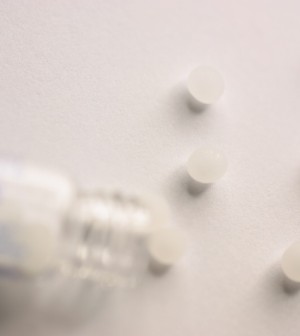- Navigating Your Midlife Crisis: Embracing New Possibilities
- City Raccoons Showing Signs of Domestication
- Mapping the Exposome: Science Broadens Focus to Environmental Disease Triggers
- One Week Less on Social Media Linked to Better Mental Health
- Your Brain Changes in Stages as You Age, Study Finds
- Some Suicide Victims Show No Typical Warning Signs, Study Finds
- ByHeart Formula Faces Lawsuits After Babies Sickened With Botulism
- Switch to Vegan Diet Could Cut Your Greenhouse Gas Emissions in Half
- Regular Bedtime Does Wonders for Blood Pressure
- Dining Alone Could Mean Worse Nutrition for Seniors
Is the Stethoscope Living on Borrowed Time?


A stethoscope draped across a doctor’s chest is as classic an image of medicine as a white coat or a wooden tongue depressor.
But the stethoscope is an old-fashioned device that has outlived its usefulness and should be replaced in the very near future, a pair of prominent New York City cardiologists contends.
Hand-held ultrasound devices are becoming less expensive and soon will offer a viable and preferable alternative to the stethoscope, said Dr. Jagat Narula, associate dean for global affairs at Mount Sinai School of Medicine and editor-in-chief of the journal Global Heart. His editorial outlining the argument was published recently in the journal.
Doctors of the future will tote a small ultrasound device around in their pocket and use it to peek at a person’s internal organs, rather than listening to the organs with a stethoscope, Narula wrote with his Mount Sinai colleague Dr. Bret Nelson.
“We should be able to replace the stethoscope with ultrasound,” Narula said. “Basically the time has come that we need to ascend to a new era. We have this technology available to us, and we need to use it not only as an investigational and diagnostic tool but as a basic patient examination tool.”
That said, many doctors will not throw away their stethoscopes without a fight.
“I disagree with the author’s premise. The stethoscope is as important as it ever has been,” said Dr. Charles Cutler, chairman of the American College of Physicians’ Board of Regents. “I understand where the author is coming from, and as a world we are going more and more toward technology. But I think in medicine, more is not always better.”
The stethoscope dates back to 1816, when it was invented in Paris by the French physician Rene Laennec. Laennec pioneered its use in diagnosing chest conditions, and it has since become a standard piece of equipment in basic patient examinations.
Ultrasound technology came along in the 1950s, and has gotten more portable and more accurate over time, Narula pointed out. Doctors can now purchase a device not much larger than a deck of cards, with the technology and screen of modern smartphones, for between $8,000 and $10,000.
“As competition arises, I believe this will be between $1,000 and $2,000 within a year or two,” Narula said. “Once it is at that cost, it will be used much more commonly than it is used today.”
Ultrasound allows a doctor to actually see a patient’s organs, rather than listening to them for clues of illness, he explained. This will reduce the need for unnecessary testing, he argued, as doctors will be able to see for themselves rather than sending a patient for a follow-up CT scan or MRI.
“You can look at almost everything, right there at the bedside or examination room,” Narula said. “Most of the time, the technology takes you away from the patient. By doing this, we will be bringing back the relationship between the doctor and the patient.”
But Cutler believes the opposite will occur, and more unnecessary tests will take place because doctors will see many things they can’t interpret.
“An ultrasound will turn up things that may not be there,” Cutler said, providing the example of a heart valve that looks a little different on an ultrasound, leading the doctor to call for a CT scan. “It may be a false alarm, but now you have ordered the test and you have worried the patient,” he explained.
Another expert pointed out another downside with ultrasound technology.
Adopting ultrasound will also place a huge burden on medical students, who will have to learn how to properly read ultrasound results on top of their already packed curriculum, said Dr. Robert Bonow, a cardiologist at Northwestern Memorial Hospital in Chicago and a spokesman for the American Heart Association.
But Narula believes ultrasound will become more ubiquitous as medical schools begin teaching use of the technology as a common examination tool.
“I think it has to be a part of culture, and it will become part of culture when we begin using it in medical school,” Narula said.
However, cost will be a deciding factor that keeps ultrasound technology from replacing the stethoscope anytime soon, Cutler said.
“A stethoscope costs $25,” he said. “Why should the medical system spend millions of dollars on equipment when they don’t have to? They could spend a fraction of the cost on stethoscopes.”
Bonow shares Cutler’s concerns. He likens ultrasound to the hand-held medical device used in “Star Trek” that doctors waved over patients.
“I believe that’s not going to be science fiction in 30 to 50 years, but going from here to there is going to take several steps we’re going to have to explore,” Bonow said. “Maybe we should give 50 percent of the medical students training in this device and see how well they perform relative to the others. But I don’t think we’re ready to throw away the stethoscope.”
More information
Visit the U.S. National Library of Medicine for more on ultrasound devices.
Source: HealthDay
Copyright © 2025 HealthDay. All rights reserved.










